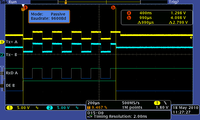CQ485: RS485/422 repeater and isolator
CQ485 is an RS485 and RS422 repeater, converter and isolator in one device. Both sides are galvanically isolated. Communication speed up to 921.6 kBd. Easy setup software included. Configuration via USB interface.
Where is this Isolator / Repeater needed?
Lines RS485 and RS422 are often used in Industry. Although those lines are very rugged and can run as far as 1200m, sometimes you need a repeater or an isolator. When? Let us see:
- If you want to run further than 1200m.
- In case you use star connection (line is not connected as a bus) you need to isolate far points of the star.
- When the device is not galvanic isolated from the power supply (against ground loops).
Communication interfaces
CQ485 has two communication interfaces - each of those can be configured as: RS485, RS422 or RS422 multimaster. Both interfaces are completely isolated from each other. According to set-up you can have RS485 or RS422 isolator/repeater. Or you can convert RS485 to RS422 and vice versa while isolating those two. RS422 multimaster is also available.
Features
- Complete galvanic isolation (including the GND) of both lines from each other and from power circuits
- Second galvanic isolation of both lines from power GND (optional)
- Complete signal reconstruction (depending on the mode)
- The RS485/422 line (including the grounding) is completely isolated from USB and from the power supply (this isolation is provided as standard for all types)
- Optionally, second galvanic isolation of both lines from the power supply ground.
- Transmission speed up to 921,6 kBd
- Enhanced overvoltage protection for both lines.
- Automatic direction control with no delay.
- Wide range of the power voltage
- Easy setting using supplied software (or via terminal) over a USB interface.
- Easy installation.
- Adjustable termination including resistors defining the idle state of the line.
- All signals connected via a slip-on terminal.
- Rugged metal enclosure with optional DIN rail holder
Transmission modes
CQ485 module can work in these three data transmission modes:
- Passive mode: Data are shaped by TTL circuits; converter does not introduce any delay to the signal.
Passive data ttransmission. Corrects edges of signals - no noticable delay is added the the transmission. (yellow - data in; light blue - data out)
- Passive mode with timing: This mode is suitable for special communication lines as CC-Link from Mitsubishi, or in special types of MODBUS RTU where there is need to separate individual packets. CQ485 inserts a delay of set-up length behind last stop bit. During this time CQ485 holds the line for itself.
This mode works very similar to the passive mode. The addition is in setting delay after receiving stop bit. Following example shows converter with 400µs delay. (yellow - data in; light blue - data out)
- Active mode: Data are received and transmitted by a processor where those are completely reconstructed. The delay coming from that process is one byte.
Active transmission mode: Data are received and transmitted by a processor where those are completely reconstructed. The delay coming from that process is one byte. (yellow - data in; light blue - data out)
CQ485 configuration
Most of the parameters (besides termination and idle-state-defining resistors) are adjustable via USB interface on the side of CQ485 module. To do that, you can use added software or any terminal program (for example Hyperterminal, which is contained in OS Windows.
| WEBVyrobce | Papouch.com |



























